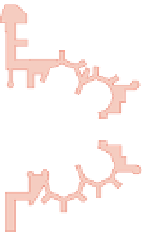Travel Reference
In-Depth Information
Westminster Abbey
3
North
Doorway
Chapel of
St. Paul
4
5
6
Sanctuary
9
N. Aisle
Organ
Gallery
10
11
West
Doorway
7
8
Choir
2
Nave
S. Aisle
12
1
Chapel of
St. Nicholas
Chapel of
St. Edmund
Chapel of
Chapel of
St. Nicholas
St. Nicholas
Chapel of
16
Chapel of
St. Edmund
13
St. Edmund
Jerusalem
Jerusalem
Chamber
Jerusalem
Chamber
Chamber
Cloisters
Deanery
14
Chapter
House
Chapel of
Chapel of
the P
y
x
Chapel of
the Pyx
the Pyx
4
Dean's
Yard
0
100 ft
15
0
30 m
Abbey Museum
15
Bookshop
16
Chapel of St. John
the Baptist
6
Chapel of St. John
the Evangelist
5
Chapter House
14
Henry V's Chantry
8
Poet's Corner
13
Royal Air Force Chapel
11
St. Andrew's Chapel
3
St. Edward's Chapel
(Coronation Chair)
7
St. George's Chapel
1
St. Michael's Chapel
4
Tomb of Henry VII
10
Tomb of Mary I &
Elizabeth I
9
Tomb of Mary,
Queen of Scots
12
Tomb of the Unknown Warrior/
Memorial to Churchill
2
Westminster Abbey
ABBEY The Abbey is not just one of the finest
examples of ecclesiastical architecture in Europe, it's also the shrine of the nation
where monarchs are anointed before their god and memorials to the nation's greatest
figures fill every corner. From the outside, it's a magnificently earnest-looking struc-
ture, its two great square towers and pointed arches the very epitome of medieval
Gothic. The building was begun in 1245 under the reign of Henry II and finally
completed in the early 16th century. This replaced an earlier structure commissioned
in 1045 by Edward the Confessor (which itself had replaced a 7th-century original)
and was consecrated in 1065, just in time to play host to Edward's funeral and (fol-
lowing a brief tussle in Hastings) the coronation of William the Conqueror. It has
been, with a couple of exceptions, the setting for every coronation since, and it is here
on April 29, 2011, that Prince William married Kate Middleton.
More or less at the center of the Abbey stands the shrine of Edward the Confessor,
while scattered around are the tombs of various other royals, including Henry V, Eliza-
beth I, and Richard III. Splendid as they are, they are all rather overshadowed by the
tomb of Henry VII. This elaborately carved, gilded structure, the work of the Italian
artist Torrigiano (a contemporary and sometime rival of Michelangelo), introduced
Renaissance lushness to the Abbey's otherwise overwhelmingly austere, Gothic confines.







































































































































































